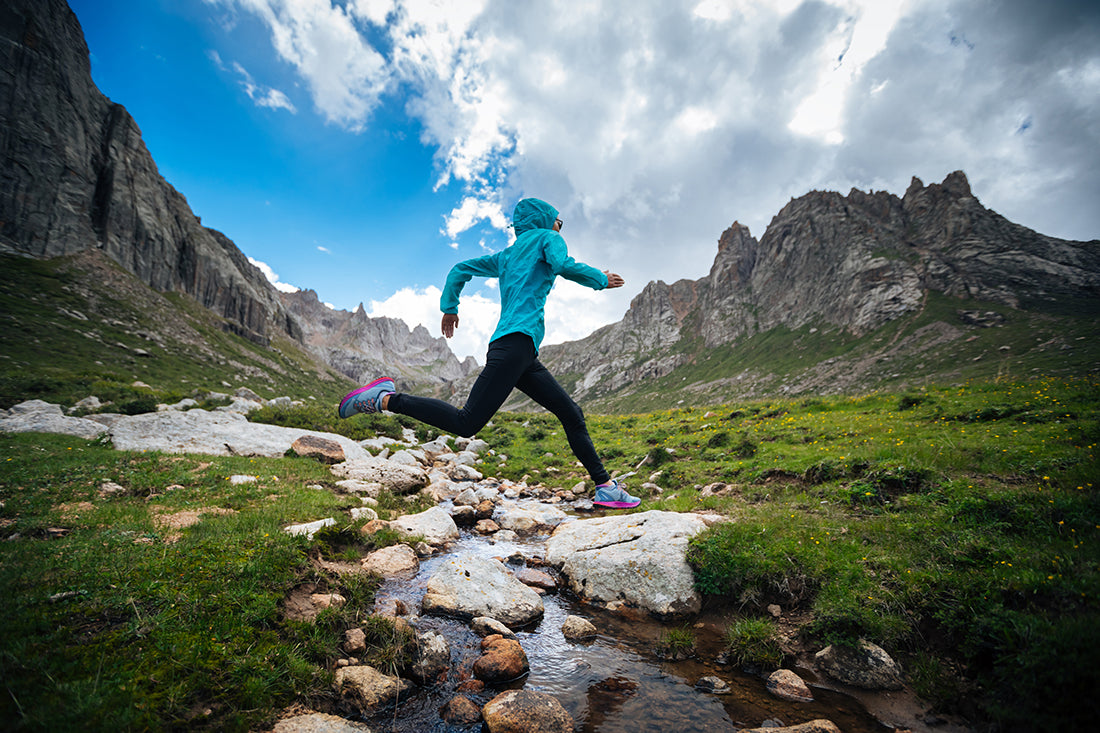A Comprehensive Guide to Trail Running
Trail running, a sport that combines the physical endurance of long-distance running with the thrill of off-road navigation, has been growing in popularity over the past few years. This guide aims to provide a comprehensive overview of trail running, with insights from Running Coach, Eric McIntyre, along with tips on how to start trail running, ways to prevent common running injuries, and the potential benefits of using CBD balm for running pain and injuries.
Understanding Trail Running
"Trail running is a sport that consists of running and hiking over trails. In the United Kingdom and Ireland, it is also called mountain or fell running. It differs from road running and track running in that it generally takes place on hiking trails, often in mountainous terrain, where there can be much larger ascents and descents." - Wikipedia Trail running is not just about the physical exertion; it's also about connecting with nature and exploring new terrains. Unlike typical road running, trail running takes you off the beaten path and into the heart of the wilderness. It's an exhilarating way to boost your fitness, improve your mental health, and connect with the great outdoors. Trail running and mountain running often involve navigating uneven terrain, which requires specialized gear and techniques.
How to Start Trail Running
Starting to run on trails can be a thrilling experience, but it also requires careful preparation and sensible precautions. Here are some tips on how to embark on your trail running journey:
-
Find the Right Shoes: Trail shoes are designed for off-road routes with rocks, mud, roots or other obstacles. They are beefier than road-running shoes, offering more traction, stability, and underfoot protection. Look for trail running shoes that provide excellent grip and shock absorbency to handle the challenges of uneven terrain.
-
Get the Appropriate Gear: Apart from shoes, other essential trail running gear includes moisture-wicking clothing, a hydration pack, energy food, a fitness tracker, navigational tools, a headlamp for night runs, and a first-aid kit.
-
Choose Your Trail: Start with simple, well-marked trails before moving on to more challenging terrains. Use guidebooks, websites, or local running clubs to find suitable trails. Apps like AllTrails can help you find trails near you.
-
Change Your Focus: Trail running involves a different focus than road running. Trail Runners often focus on effort over speed and time over distance, especially when tackling height variations in mountain running.
Choosing the Right Gear for Trail Running

The right gear can enhance your trail running experience, providing comfort, safety, and performance benefits. Here's what you need to consider:
-
Shoes: Trail running shoes offer better traction and underfoot protection than standard running shoes. They come in various styles, ranging from minimalist designs that provide a better feel of the trail to maximalist styles that offer more cushioning. The Hoka Mafate Speed 4 is a great example of a shoe that balances comfort and traction. For wet conditions, consider waterproof trail running shoes or gore tex trail running shoes. Brands like Scarpa shoes and Altra trail running shoes are known for their quality and performance in trail and ultra running shoes.
-
Clothing: Opt for moisture-wicking materials like merino wool or synthetics over cotton. Dress in layers to manage your comfort throughout your run. If you are someone who blisters easily, using a combination of Injinji Toe Sock and Bodyglide can be a life saver.
-
Hydration Packs: Hydration is crucial in trail running. Options include handheld water bottles, waist packs with water bottles, or hydration vests. My go-tos include the Salomon ADV Skin 5 or the Ultraspire Speedgoat 3.0 Waist Pack.
-
Energy Food: For longer runs, carry energy bars, gels, or chews. Experiment with different foods to see what works best for you. I like to start with a pre-run snack & CBD energy gummy then fuel every 30-45 min with running gels. Aim to get 40-60g of carbs per hour of running for runs over 90 min.
-
Navigation Tools: A map, compass, or GPS unit can be invaluable when running in unfamiliar terrain. My watch of choice is the Garmin Fenix 5X+
-
Lights: If you plan to run at night, a headlamp with an output of at least 200 lumens is a must. One budget option that has worked great for me is the Nitecore headlamp from Amazon.
-
First-Aid Kit: Always carry a basic first-aid kit. Include bandages, antibacterial ointment, pain medication, and foot care items like moleskin and blister bandages.
Preparing Your Body for Trail Running

Before hitting the trails, it's crucial to prepare your body for the unique challenges of trail running. Here are some tips:
-
Start Slow: If you're new to trail running, start with shorter, less technical trails and gradually increase your distance and trail difficulty over time.
-
Cross-Training: Incorporate exercises like strength training and flexibility workouts into your routine to boost your trail running performance and prevent injuries.
-
Listen to Your Body: Pay attention to how your body feels during and after runs. If you feel pain or discomfort, give your body time to rest and recover.
Training for Trail Running
Training for trail running requires a different approach than road running due to the variable terrain and increased ascents and descents. Here's what you need to consider:
-
Train by effort rather than pace: Due to varying terrain it can be hard to compare trail segments. Instead of aiming to hit a particular pace, get familiar with how your body feels at certain paces, then translate that feeling to the trail.
-
Hill Workouts: Incorporate uphill and downhill runs into your training to build strength and improve your running form on ascents and descents. This can be shorter hill repeat/interval type sessions or even longer extended mountain sessions.
-
Strength and Balance Exercises: These can help you navigate tricky trail features and reduce the risk of falls and injuries. Trail Runners should add in plyometrics and heavy strength training to their routine to prepare for the varying terrain.
-
Mental Training: Trail running can be mentally challenging due to the long distances and tough terrain. Practice mindfulness and visualization techniques to boost your mental resilience.
Trail Running Nutrition
Proper nutrition is essential for trail running performance and recovery. Here's what you need to know:
-
Hydrate: Drink plenty of water before, during, and after your run. For longer runs, consider using a hydration pack or belt.
-
Fuel Up: Your body needs carbohydrates to fuel your run. Eat a high-carb meal 2-3 hours before your run.
-
Snacks: For runs longer than an hour, bring energy bars, gels, or chews to maintain your energy levels. If your run is longer than 90 minutes then aim to get 40-60g of carbohydrates PER HOUR that you are out on the trails.
-
Recovery Nutrition: After your run, consume a meal or snack with protein and carbs to aid in recovery.
Trail Running Safety
Safety is paramount when trail running. Here's how you can stay safe on the trails:
-
Plan Your Route: Know the details of your route before you set out, including the length, elevation changes, and any potential hazards.
-
Tell Someone: Always let someone know where you're going and when you expect to return.
-
Be Weather Wise: Check the weather forecast before your run and dress appropriately. Water-resistant or waterproof running shoes can be beneficial in wet conditions.
-
Carry a First-Aid Kit: A basic first-aid kit can be a lifesaver in case of minor injuries.
Common Running Injuries and How to Prevent Them
Trail running can pose a risk of injuries, such as sprains, strains, and fractures. Here's how to prevent common running injuries:
-
Warm Up and Cool Down: Start each run with a warm-up and end with a cool-down to prepare your body for exercise and aid recovery. A warm-up should aim to quite literally warm-up the muscles you intend to use. I like to rub some Activate CBD Balm on my knees and ankles to start that process before getting moving.
-
Cross Train: Incorporate strength training, flexibility exercises, and balance drills into your routine to build a well-rounded fitness foundation. Many injuries are caused by a mix of imbalances being emphasized through excess training volume. Cross-training will help even you out.
-
Listen to Your Body: Rest and recover if you're feeling pain or fatigue. Pushing through pain can lead to serious injuries. It’s estimated over 50% of running injuries are overuse injuries, push your limits but don’t always push past them!
-
Get a Running Coach: A qualified running coach can provide personalized training plans and advice to help prevent injuries.
Using CBD Balm for Running Pain and Injuries
CBD balm is becoming increasingly popular among runners for its potential to alleviate pain and inflammation associated with running injuries. Here's how you can use CBD balm for running pain and injuries:
-
Pain Relief: Apply CBD balm to the affected area to potentially reduce pain and inflammation. I like to apply Activate balm to problem areas before my run to help warm-up then Recovery balm afterwards to start that process.
-
Recovery Aid: Regular use of CBD balm might aid in faster recovery from running injuries by reducing inflammation. In addition, reduced stress can lower cortisol levels allowing you to recover faster. Using CBD drops can help you relax and decompress after a long workout or long day at work.
-
Skin Health: CBD balms and lotions can also help moisturize the skin and may help with conditions like blisters and chafing.
Note: Always consult with a healthcare professional before starting any new treatment. By following these tips and guidelines, you can enjoy the benefits of trail running while minimizing the risk of injuries. Whether you're a seasoned runner or a newbie, trail running offers a unique and rewarding way to connect with nature and stay fit. Happy trails!












































